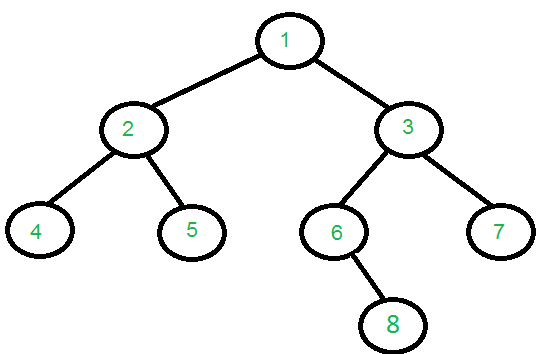欧拉树巡回讨论已经讨论过,它将树的层次结构展平为精确包含2 * N-1值的数组。在这篇文章中,任务是证明Euler Tour Tree的度是节点数的2倍减1。这里的度数表示在Euler Tour中遍历的节点总数。
例子:
Input:
Output: 15
Input:
Output: 17
解释:
使用示例1 :

在哪里
It can be seen that each node’s count in Euler Tour is exactly equal to the out-degree of node plus 1.
Mathematically, it can be represented as:![Rendered by QuickLaTeX.com $\displaystyle Total=\sum_{node_i=1}^{N} Out_D_e_g[node_i]+1$](https://mangdo-1254073825.cos.ap-chengdu.myqcloud.com//front_eng_imgs/geeksforgeeks2021/Total%20nodes%20traversed%20in%20Euler%20Tour%20Tree_4.jpg)
![Rendered by QuickLaTeX.com $\displaystyle Total= N + \sum_{node_i=1}^{N} Out_D_e_g[node_i]$](https://mangdo-1254073825.cos.ap-chengdu.myqcloud.com//front_eng_imgs/geeksforgeeks2021/Total%20nodes%20traversed%20in%20Euler%20Tour%20Tree_5.jpg)
Where
Total represents total number of nodes in Euler Tour Tree
![]() represents ith node in given Tree
represents ith node in given Tree
N represents the total number of node in given Tree
![]() represents number of child of
represents number of child of ![]()
C++
// C++ program to check the number of nodes
// in Euler Tour tree.
#include
using namespace std;
#define MAX 1001
// Adjacency list representation of tree
vector adj[MAX];
// Function to add edges to tree
void add_edge(int u, int v)
{
adj[u].push_back(v);
}
// Program to check if calculated Value is
// equal to 2*size-1
void checkTotalNumberofNodes(int actualAnswer,
int size)
{
int calculatedAnswer = size;
// Add out-degree of each node
for (int i = 1; i <= size; i++)
calculatedAnswer += adj[i].size();
if (actualAnswer == calculatedAnswer)
cout << "Calculated Answer is " << calculatedAnswer
<< " and is Equal to Actual Answer\n";
else
cout << "Calculated Answer is Incorrect\n";
}
int main()
{ // Constructing 1st tree from example
int N = 8;
add_edge(1, 2);
add_edge(1, 3);
add_edge(2, 4);
add_edge(2, 5);
add_edge(3, 6);
add_edge(3, 7);
add_edge(6, 8);
// Out_deg[node[i]] is equal to adj[i].size()
checkTotalNumberofNodes(2 * N - 1, N);
// clear previous stored tree
for (int i = 1; i <= N; i++)
adj[i].clear();
// Constructing 2nd tree from example
N = 9;
add_edge(1, 2);
add_edge(1, 3);
add_edge(2, 4);
add_edge(2, 5);
add_edge(2, 6);
add_edge(3, 9);
add_edge(5, 7);
add_edge(5, 8);
// Out_deg[node[i]] is equal to adj[i].size()
checkTotalNumberofNodes(2 * N - 1, N);
return 0;
} Java
// Java program to check the number of nodes
// in Euler Tour tree.
import java.util.*;
class GFG
{
static final int MAX = 1001;
// Adjacency list representation of tree
static Vector[] adj = new Vector[MAX];
// Function to add edges to tree
static void add_edge(int u, int v)
{
adj[u].add(v);
}
// Program to check if calculated Value is
// equal to 2*size-1
static void checkTotalNumberofNodes(int actualAnswer,
int size)
{
int calculatedAnswer = size;
// Add out-degree of each node
for (int i = 1; i <= size; i++)
calculatedAnswer += adj[i].size();
if (actualAnswer == calculatedAnswer)
System.out.print("Calculated Answer is " +
calculatedAnswer +
" and is Equal to Actual Answer\n");
else
System.out.print("Calculated Answer is Incorrect\n");
}
// Driver Code
public static void main(String[] args)
{
for (int i = 0; i < MAX; i++)
adj[i] = new Vector();
// Constructing 1st tree from example
int N = 8;
add_edge(1, 2);
add_edge(1, 3);
add_edge(2, 4);
add_edge(2, 5);
add_edge(3, 6);
add_edge(3, 7);
add_edge(6, 8);
// Out_deg[node[i]] is equal to adj[i].size()
checkTotalNumberofNodes(2 * N - 1, N);
// clear previous stored tree
for (int i = 1; i <= N; i++)
adj[i].clear();
// Constructing 2nd tree from example
N = 9;
add_edge(1, 2);
add_edge(1, 3);
add_edge(2, 4);
add_edge(2, 5);
add_edge(2, 6);
add_edge(3, 9);
add_edge(5, 7);
add_edge(5, 8);
// Out_deg[node[i]] is equal to adj[i].size()
checkTotalNumberofNodes(2 * N - 1, N);
}
}
// This code is contributed by Rajput-Ji C#
// C# program to check the number
// of nodes in Euler Tour tree.
using System;
using System.Collections.Generic;
class GFG
{
static readonly int MAX = 1001;
// Adjacency list representation of tree
static List[] adj = new List[MAX];
// Function to add edges to tree
static void add_edge(int u, int v)
{
adj[u].Add(v);
}
// Program to check if calculated Value is
// equal to 2*size-1
static void checkTotalNumberofNodes(int actualAnswer,
int size)
{
int calculatedAnswer = size;
// Add out-degree of each node
for (int i = 1; i <= size; i++)
calculatedAnswer += adj[i].Count;
if (actualAnswer == calculatedAnswer)
Console.Write("Calculated Answer is " +
calculatedAnswer +
" and is Equal to Actual Answer\n");
else
Console.Write("Calculated Answer " +
"is Incorrect\n");
}
// Driver Code
public static void Main(String[] args)
{
for (int i = 0; i < MAX; i++)
adj[i] = new List();
// Constructing 1st tree from example
int N = 8;
add_edge(1, 2);
add_edge(1, 3);
add_edge(2, 4);
add_edge(2, 5);
add_edge(3, 6);
add_edge(3, 7);
add_edge(6, 8);
// Out_deg[node[i]] is equal to adj[i].Count
checkTotalNumberofNodes(2 * N - 1, N);
// clear previous stored tree
for (int i = 1; i <= N; i++)
adj[i].Clear();
// Constructing 2nd tree from example
N = 9;
add_edge(1, 2);
add_edge(1, 3);
add_edge(2, 4);
add_edge(2, 5);
add_edge(2, 6);
add_edge(3, 9);
add_edge(5, 7);
add_edge(5, 8);
// Out_deg[node[i]] is equal to adj[i].Count
checkTotalNumberofNodes(2 * N - 1, N);
}
}
// This code is contributed by PrinciRaj1992 输出:
Calculated Answer is 15 and is Equal to Actual Answer
Calculated Answer is 17 and is Equal to Actual Answer